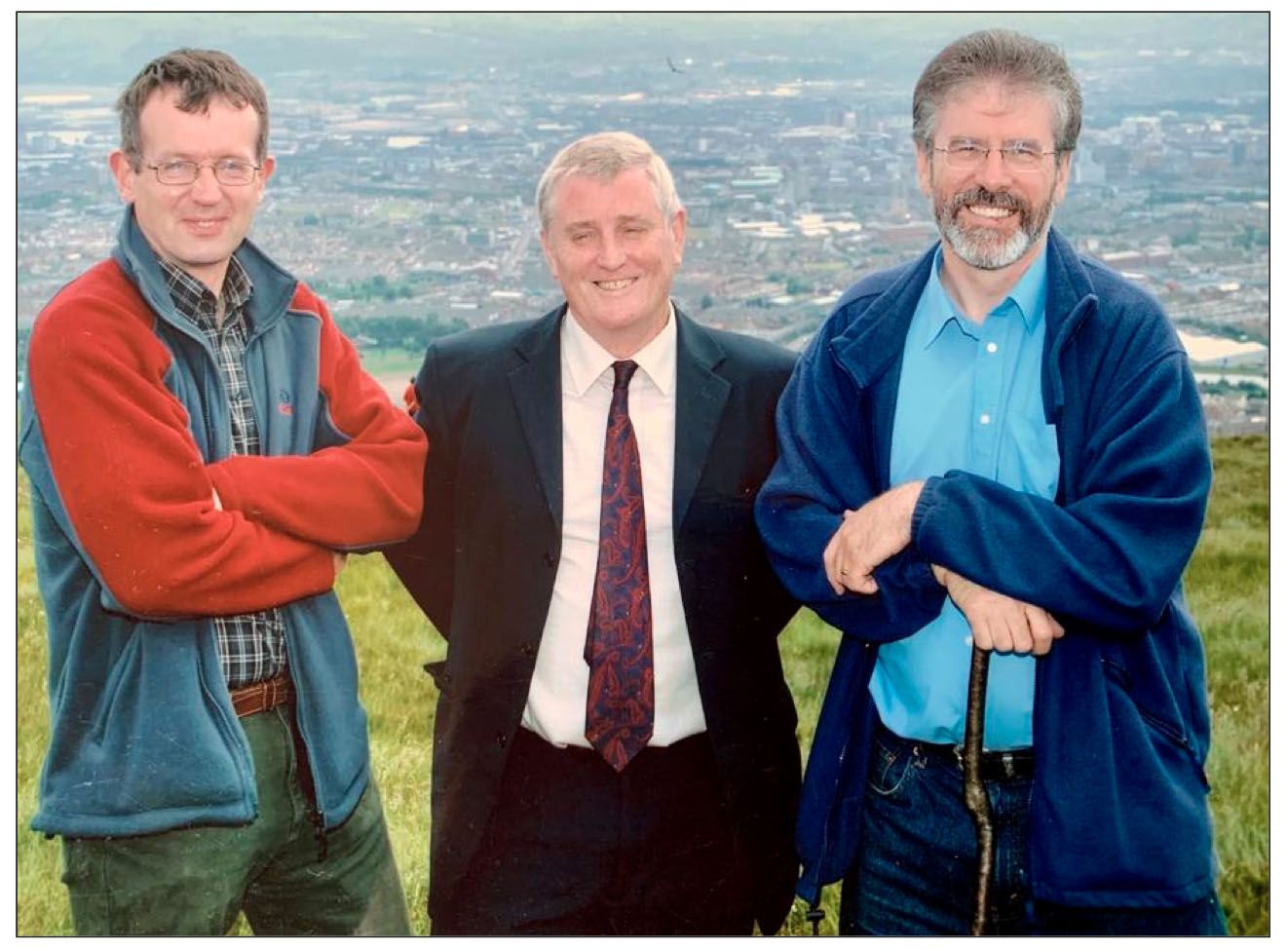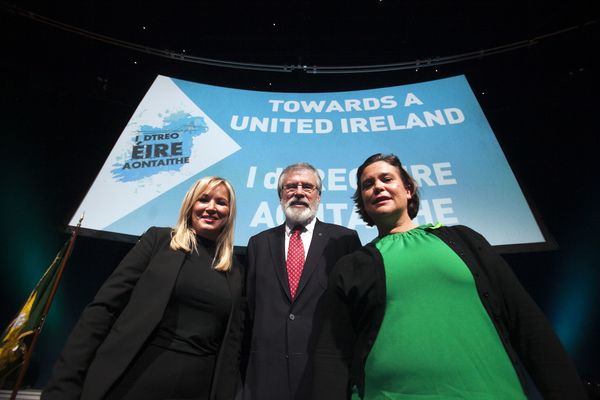I HAVE always enjoyed walking. As a youngster my brother Paddy, Joe Magee and I would tramp the Black Mountain above Ballymurphy and beyond. After we started to have dogs they became part of the adventure. The enjoyment of walking dogs, especially across open fields or hills, has remained with me all my life.
Later we graduated from walking to cycling. Joe and I went often to Glenavy and up, down and around all the countryside along that part of Lough Neagh. But we would always spend part of the journey walking.
On one occasion we took an especially memorable hitch-hiking holiday. Joe and I persuaded a van driver for Eason’s to pick us up early and take us to Derry. We felt a great sense of adventure as we were dropped off in Derry. It was 7am, there were no trains and everywhere was closed. Walking out the road to Donegal we got a lift on the back of an open lorry and we lay back, gazing at the mountains and the blue sky as we drove into Donegal. After three days and nights camping beside a graveyard in Gweedore, we made our way to Sligo and on to Galway. We stayed for a while in the City of the Tribes, which was buzzing, as ever, with young people, traditional music and its own particular brand of hectic craic.
These natural attributes are both our heritage and our legacy. They need to be conserved for future generations to enjoy and explore.”
I also got to know Leitrim very well, walking most of the area around Ballinamore in the company of John Joe McGirl. I found it to be a beautiful part of Ireland.
But wherever I walk, whether in Meath, on the Hill of Tara, across the Cooley Mountains, around the Cages of Long Kesh, or to the top of Errigal or in Cork or Kerry or on foreign shores, I always return to the Belfast Hills.
I was reminded of this reading the recent Dúlra column in the Andersonstown News. It was the story of Conor Smyth and Aaron Kelly and their amazing discovery that pine martens have returned to the Belfast Hills. The pine marten is an Irish mammal which was forced to move further and further west by the cutting down of forests and woods. Sean MacBradaigh, who lives in Leitrim, occasionally posts photos of pine martens in his part of the world but none have been seen here for generations.

The pine marten likes trees. It’s no surprise therefore that its name is cat crainn – cat of the tree. Conor and Aaron, above, found evidence last September that convinced him that pine martens had returned to the Belfast Hills. Aaron is studying animal management and he persuaded his course tutors at Belfast Met to undertake a research project to prove or disprove his contention. He set up camera traps and to his joy he caught the image of a pine marten late one night in January. Well done, Aaron.
Perfectly clear night up on Black Mountain - felt a million miles from the craziness of life right now.
— Keifermac (@keifermac1) February 28, 2021
Our city looks totally amazing from on high. If a pandemic has taught me anything then it's that I need to do this stuff much more. pic.twitter.com/oxJ1E9zRdH
And well done also to all of those who have made the Belfast Hills a success story for walkers and lovers of archaeology and fauna and birds like the red grouse, and skylarks and peregrine falcons. The view across Belfast is striking and on a clear day you can see the Mourne Mountains, the Hills of South Armagh and, it is claimed by some, the Great Sugarloaf Mountain in Wicklow. You can also see the Scottish, Cumbrian and Welsh uplands to the east.
BRITISH MILITARY CONTROL
Thirty years ago it was all so different. The British military controlled much of the land above West Belfast. In 1991 when I was MP for the constituency I called for the “the mountain range from the Colin Mountain across the Divis and Black Mountains to the Cave Hill to be declared a conservation area and developed as a nature reserve and parkland.”
In June of 1999 Sinn Féin sponsored a conference on land use in West Belfast. I told the audience: “There is a need to conserve the natural environment. Sinn Féin has consistently supported proposals to maintain the Bog Meadows and to end quarrying on the Black Mountain. We have, with others, proposed the development of a regional park on the Belfast Hills for the benefit of all our citizens. These natural attributes are both our heritage and our legacy. They need to be conserved for future generations to enjoy and explore.”
During that time many local community groups and environmental campaigners like the late Terry Enright campaigned hard to preserve the Hills. Part of this included an annual Belfast Hills Walk which would attract thousands.
At the same time there was a campaign to end quarrying, demilitarise the Hills and for the British Military presence on Divis Mountain to end. The demand was for the British Ministry of Defence to gift the site at Divis Mountain to the Belfast Hills Trust. In June 2000 I wrote to Adam Ingram, who was then one of Mo Mowlam’s Ministers of State in the NIO. I raised with him the future of “1600 acres of land on Divis Mountain, above Belfast” that had been declared surplus to requirements by the British military and which it planned to sell it off. I said in my letter: “If this land is now available I would suggest that consideration should be given to handing it over to a body which would open up its potential, and provide managed access for the people of Belfast, while at the same time conserving the natural beauty and wildlife of this landscape.”
Subsequently I raised the issue with Mo Mowlam and with Tony Blair, the British Prime Minister. After two years of intense lobbying it was announced in September 2003 that the National Trust had been successful in buying Divis Mountain with the support of the Heritage Lottery Commission and the Environmental Heritage Service. The Trust outlined its plans to open up access on the mountain for the people of Belfast to enjoy.
CAVE HILL AND CARNMONEY
The Belfast Hills project has never looked back. It stretches from Boomer’s Hill and the Colin Mountain in the west across to the Black Mountain and Divis Mountain and to Squire’s Hill and Cave Hill and then to Carnmoney.
The numbers of people who walk the Belfast Hills now every week is amazing. In fact so many want to enjoy the serenity and beauty of the Hills that parking has become a real problem at the Divis Road entrance and recently Paul Maskey MP has been negotiating the provision of additional facilities.
The development of the Belfast Hills in the interests of citizens is a success story. But much more is possible. It is possible to continue to enhance the facilities, educational and environmental potential and accessibility to the public of the Belfast Hills and to continue to see this significant natural resource continue to be developed in the interests of future generations.
NEVER GIVE UP
DATES can evoke powerful memories for all of us. The birth or death of a loved one; a wedding; a new job; a joyous family occasion or a tragedy. Some memories can be so strong that it’s as if we are still there now. The smells, the noise, the fear, the joy, the sadness.
March first, the date I pen these words, is one of those dates for me. 40 years ago at around this time Bobby Sands refused his breakfast and commenced his first day of hunger strike. This was the second hunger strike in six months. In the first day of his prison diary Bobby wrote: “I have considered all the arguments and tried every means to avoid what has become the unavoidable: it has been forced upon me and my comrades by four-and-a-half years of stark inhumanity.”
NEVER DESPAIR: The funeral of Bobby Sands moves through Twinbrook in 1981
After the end of the first hunger strike on December 18, 1980 every effort was made to avoid a second hunger strike. Through the remaining weeks of that year and into January and February every effort was made to bring the prison protests to an agreed settlement.
But the Brits saw the ending of the first hunger strike as weakness by the blanket men and the women in Armagh. Despite almost five years of horrendous conditions; of beatings and isolation; of forced washes and deprivation and violence their commitment and their determination to challenge the prison system was truly inspiring.
OTD 40 yrs ago I shook hands in H Block 3 with Bobby Sands as he embarked on his hunger strike that resulted in his death 66 days later. Those of us privileged to know Bobby will never forget his courage, heroism & humanity. ‘ Our revenge will be the laughter of our children’. pic.twitter.com/OE13VLk0qE
— Pat Sheehan (@PatSheehanMLA) March 1, 2021
Bobby underlined this collective and powerful state of mind for me when he wrote on March 12 in his diary: “This is most important. Nothing else seems to matter except that lingering constant reminding thought, ‘Never give up.’ No matter how bad, how black, how painful, how heart-breaking, ‘Never give up.’ ‘Never despair.’ ‘Never lose hope.’”








